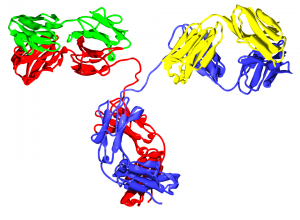Using Pepsin to Prepare F(ab’)2 Fragments
Pepsin is commonly used in the preparation of F(ab’)2 fragments from antibodies. In some assays, it is preferable to use only the antigen-binding (Fab) portion of the antibody. For these applications, antibodies may be enzymatically digested to produce an F(ab’)2 fragment of the antibody. To produce an F(ab’)2 fragment, IgG is digested with pepsin, which cleaves the heavy chains near the hinge region. One or more of the disulfide bonds that join the heavy chains in the hinge region are preserved, so the two Fab regions of the antibody remain joined together, yielding a divalent molecule (containing two antibody binding sites), hence the designation F(ab’)2. The light chains remain intact and attached to the heavy chain. The Fc fragment is digested into small peptides.
References
- Kim, D. et al. (2011) Insights into the regulatory mechanism controlling the inhibition of vaccine-induced seroconversion by maternal antibodies. Blood, 117, 6143-51.
- Jovanovic, D. et al. (2010) CD101 expression and function in normal and rheumatoid arthritis-affected human T cells and monocytes/macrophages. J. Rheumatology, 38, 419-28.
- Song, J-D. et al. (2009) Anti-Siglec-F antibody reduces allergen-induced eosinophilic inflammation and airway remodeling. J. Immunology, 183, 5333-46.
Hydrogen-Deuterium Exchange
Hydrogen–deuterium exchange is a chemical reaction in which a covalently bonded hydrogen atom is replaced by a deuterium atom. The method gives information regarding the tertiary structure of the protein.
The minimum exchange rate occurs at approximately pH 2.6. By performing the exchange at neutral pH and then rapidly changing the pH, the exchange rates of the backbone amide hydrogens can be dramatically slowed, or quenched.
The location and relative amount of deuterium exchange along the peptide backbone can be determined roughly by subjecting the protein to proteolysis after the exchange reaction has been quenched. Individual peptides are then analyzed for overall deuteration of each peptide fragment. Using this technique the resolution of deuterium exchange is determined by the size of the peptides produced during digestion Pepsin, an acid protease, is commonly used for proteolysis, as the quench pH must be maintained during the proteolytic reaction.
References
- Qi, Y. et al. (2011) Binding of cyclic diguanylate in the non-catalytic EAL domain of FimX induces a long-range conformational change. J. Biol. Chem. 286, 2910-17.
- Rey, M. et al. (2010) Conformational dynamics of the bovine mitochondrial ADP/ATP carrier isoform 1 revealed by hydrogen/deuterium exchange coupled to mass spectrometry. J. Biol. Chem. 285, 34981-990.
- Brier, S et al. (2010) Mapping surface accessibility of the C1r/C1s tetramer by chemical modification and mass spectrometry provides new insights into assembly of the human C1 complex. J. Biol. Chem. 285, 32251- 263.
- Golczak, M. and Palczewski, K. (2010) An acyl-covalent enzyme intermediate of lecithin:retinol acyltransferase. J. Biol.Chem. 285, 29217-222.
Are you looking for proteases to use in your research?
Explore our portfolio of proteases today.

